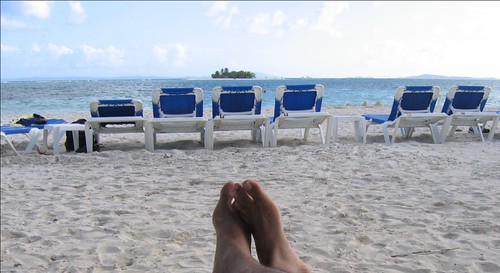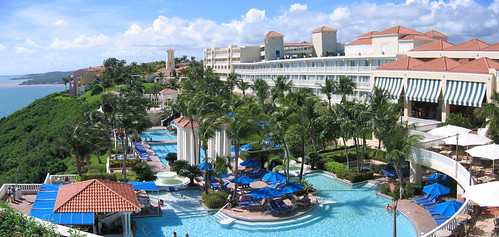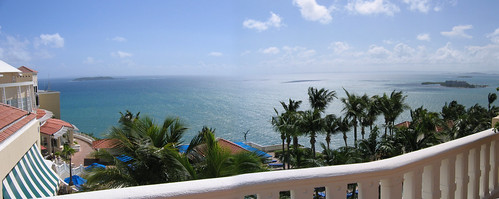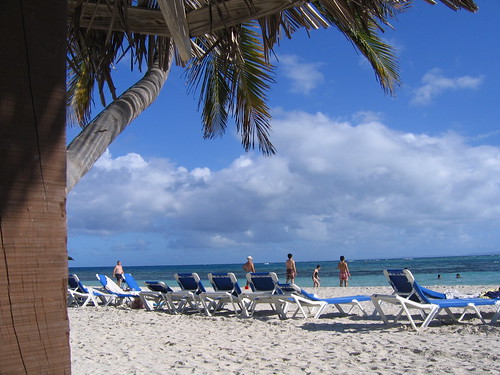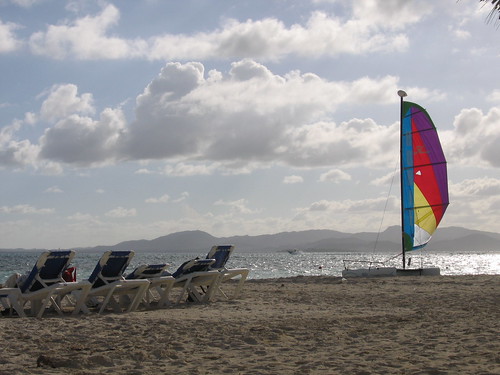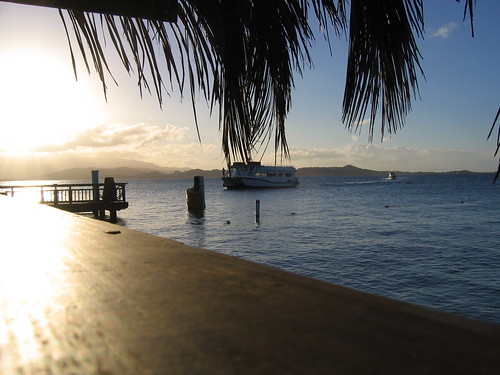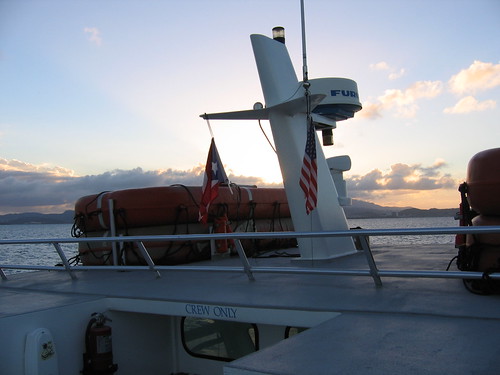Farm in Africa
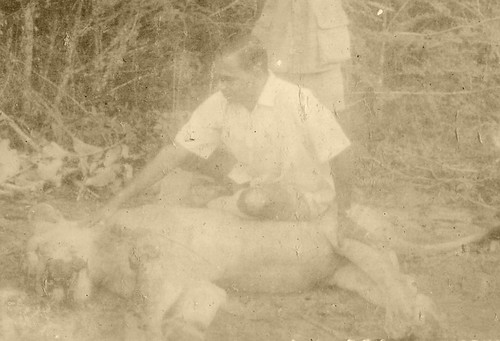
My grandparents had a farm in Africa at the edge of the Indian Ocean. It was in Mtwara, Tanzania --- right on the sea-shore, I am told. This faded photograph shows my grandfather with the carcass of a lioness that had been caught trespassing. Here's one that shows my grandmother sitting, uncomfortably and in a sari, on the same lioness. I'm guessing the posing with the lioness was my grandfather's idea.
I like these old photographs as they show my grandparents in a time and place and in circumstances that I am not used to seeing them. My grandfather looking dapper in a white suit and various interesting hats, my grandmother at a "sundowner" (I don't remember ever seeing alcohol in my grandparents house in Kerala), my grandfather on a motorbike, with the rest of his soccer team (who seem to have had a penchant for interesting headgear). And then there's this adorable (and nicely framed) picture of my mother and her two siblings:
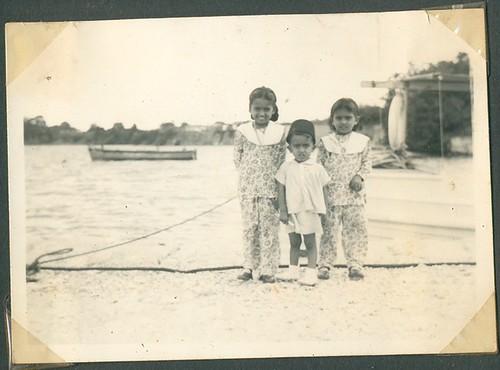
I'm in awe of my grandfather's spirit of adventure and perseverence that would take him, a high-school graduate, from the village of Kumbanad in Kerala to running a successful agricultural business in a far away land. It appears that Kumbanad, a village that I have visited precisely once in my life, has had an especially strong culture of emigration. This Outlook magazine article talks of how the village today is made up of old people whose children and grandchildren are in foreign countries.
 At the time the first step to finding a job overseas was to go to Bombay. Not long after graduating from high-school he did exactly that. It was in his office in Bombay that he met my grandmother (as I was surprised to find out, knowing how involved he was in his children's marital decisions). While in Bombay, after several attempts, he found a job with a company in East Africa.
At the time the first step to finding a job overseas was to go to Bombay. Not long after graduating from high-school he did exactly that. It was in his office in Bombay that he met my grandmother (as I was surprised to find out, knowing how involved he was in his children's marital decisions). While in Bombay, after several attempts, he found a job with a company in East Africa.
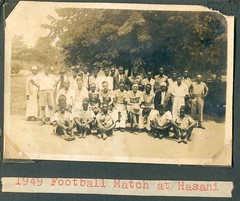 My grandparents' time in Africa, especially after the birth of their children, is quite well-documented in several photo albums. When I was at home recently I scanned in the oldest of those albums: faded pictures and all. It appears that his first appointment was in the Hasani Estates in Makanya (near the Tanga Railway Line), in the north of the country near the border with the Kenya. After a couple of years there they moved down to Mikindani in the south (near the Mozambique border) where my grandfather worked at the sisal estates. Sisal is a kind of plant fiber used for making rope. The Mikindani Sisal estate appears to be owned today by the same family that owned it then --- the Karimjee/Jivanjees. Here's a quote from a now-dead web-page that was cached by google :
My grandparents' time in Africa, especially after the birth of their children, is quite well-documented in several photo albums. When I was at home recently I scanned in the oldest of those albums: faded pictures and all. It appears that his first appointment was in the Hasani Estates in Makanya (near the Tanga Railway Line), in the north of the country near the border with the Kenya. After a couple of years there they moved down to Mikindani in the south (near the Mozambique border) where my grandfather worked at the sisal estates. Sisal is a kind of plant fiber used for making rope. The Mikindani Sisal estate appears to be owned today by the same family that owned it then --- the Karimjee/Jivanjees. Here's a quote from a now-dead web-page that was cached by google :
Karimjee Jivanjee Estates Ltd was founded in 1939 to look after agricultural interests. The firm consisted of fifteen plantations growing sisal, coffee, coconuts, kapok, rubber, timber and fruits.In 1956, less than a decade after he got to Africa, my grandfather branched out on his own; starting his own estate in Mtwara (close to Mikindani) with cattle, poultry and cashews.
However acquisition of estates had commenced in 1921 with the purchase of Derema Coffee Estate in the Usambara Mountains. Derema is the oldest recorded estate in Tanganyika being formed in 1891 by the German East Africa Co. Production on Derema was changed from coffee to tea in 1933 following the damage inflicted by coffee berry disease and the 194o's saw the addition of Monga and Maramba Tea Estates in the Amani Forest.
Sisal estate acquisitions commenced in 1922 but the company's original Mtwara sisal estate was acquired by the British Government in order to create Mtwara township and harbour.
Karimjee Jivanjee Estates reached its peak in the early 1960's with sisal production at 12,500 tons per annum and tea production at 550 tons per annum.
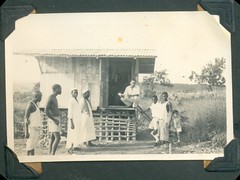 Tanzania has had a particularly comopolitan history because of its indian-ocean coast. Starting as early as the 8th century, Arabs, Persians, Indians, Chinese (possibly this guy?), Portuguese, Germans and Brits played a role. The Sultan of Oman controlled Zanzibar and the Tanganyikan coast from atleast the 18th century. The Germans started colonizing the area in the 1880s, and the Brits took over after WWI. The Germans built railway lines and introduced Sisal.
Tanzania has had a particularly comopolitan history because of its indian-ocean coast. Starting as early as the 8th century, Arabs, Persians, Indians, Chinese (possibly this guy?), Portuguese, Germans and Brits played a role. The Sultan of Oman controlled Zanzibar and the Tanganyikan coast from atleast the 18th century. The Germans started colonizing the area in the 1880s, and the Brits took over after WWI. The Germans built railway lines and introduced Sisal.
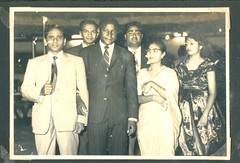 There have been Indians in East Africa for centuries. The Karimjee-Jivanjee family got to Tanzania in the 1830s (!). I'm not sure exactly why so many people from one particular part of India (Gujurat/Cutch) moved to East Africa over the past couple of centuries. Names that end in jee: Karimjee, Vassanji, Verjee, Nagji, Tyabji, Bhanji are all from a particular ethnic/religious group --- the Bohra/Ismailis of eastern India.
There have been Indians in East Africa for centuries. The Karimjee-Jivanjee family got to Tanzania in the 1830s (!). I'm not sure exactly why so many people from one particular part of India (Gujurat/Cutch) moved to East Africa over the past couple of centuries. Names that end in jee: Karimjee, Vassanji, Verjee, Nagji, Tyabji, Bhanji are all from a particular ethnic/religious group --- the Bohra/Ismailis of eastern India.
When I was an undergraduate in Texas, I was sitting at lunch one day with a kid of Indian-East-African origin (with a -ji last name). And we found out, to our astonishment, that his family came from Mtwara --- the same small town that my grandparents built their estate in.
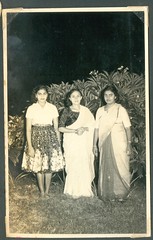 My mother's Tanzanian past caught up with her when she worked in Oman for a short while in the 90s. As the Sultan Of Oman ruled Zanzibar until the 1960s, Oman has several citizens of Zanzibari origin who speak Kiswahili (rather than Arabic). So my mother was able to understand what her colleagues were saying even when they thought she didn't (though she owned up shortly).
My mother's Tanzanian past caught up with her when she worked in Oman for a short while in the 90s. As the Sultan Of Oman ruled Zanzibar until the 1960s, Oman has several citizens of Zanzibari origin who speak Kiswahili (rather than Arabic). So my mother was able to understand what her colleagues were saying even when they thought she didn't (though she owned up shortly).
When we were kids in Kerala my grandparents used to speak to each other in Kiswahili when they didn't want us to understand. And my aunt and my mom, though much less fluent, try that occassionally even today.
Unlike these other East-African Sepia Mutiny commenters, I can't claim much more of a legacy from my grandparents' east-african sojourn. They moved back to Kerala around 1970. Here's a set of some of their pictures.
read more...
